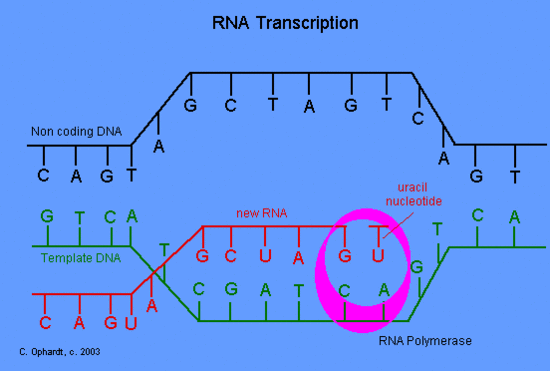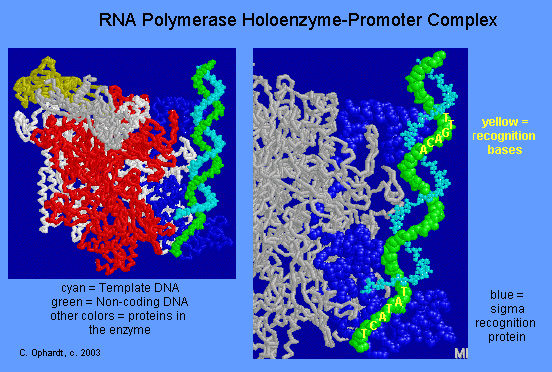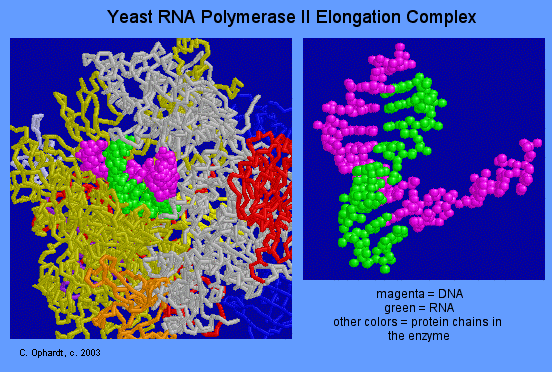RNA - Transcription
- Page ID
- 472
\( \newcommand{\vecs}[1]{\overset { \scriptstyle \rightharpoonup} {\mathbf{#1}} } \)
\( \newcommand{\vecd}[1]{\overset{-\!-\!\rightharpoonup}{\vphantom{a}\smash {#1}}} \)
\( \newcommand{\dsum}{\displaystyle\sum\limits} \)
\( \newcommand{\dint}{\displaystyle\int\limits} \)
\( \newcommand{\dlim}{\displaystyle\lim\limits} \)
\( \newcommand{\id}{\mathrm{id}}\) \( \newcommand{\Span}{\mathrm{span}}\)
( \newcommand{\kernel}{\mathrm{null}\,}\) \( \newcommand{\range}{\mathrm{range}\,}\)
\( \newcommand{\RealPart}{\mathrm{Re}}\) \( \newcommand{\ImaginaryPart}{\mathrm{Im}}\)
\( \newcommand{\Argument}{\mathrm{Arg}}\) \( \newcommand{\norm}[1]{\| #1 \|}\)
\( \newcommand{\inner}[2]{\langle #1, #2 \rangle}\)
\( \newcommand{\Span}{\mathrm{span}}\)
\( \newcommand{\id}{\mathrm{id}}\)
\( \newcommand{\Span}{\mathrm{span}}\)
\( \newcommand{\kernel}{\mathrm{null}\,}\)
\( \newcommand{\range}{\mathrm{range}\,}\)
\( \newcommand{\RealPart}{\mathrm{Re}}\)
\( \newcommand{\ImaginaryPart}{\mathrm{Im}}\)
\( \newcommand{\Argument}{\mathrm{Arg}}\)
\( \newcommand{\norm}[1]{\| #1 \|}\)
\( \newcommand{\inner}[2]{\langle #1, #2 \rangle}\)
\( \newcommand{\Span}{\mathrm{span}}\) \( \newcommand{\AA}{\unicode[.8,0]{x212B}}\)
\( \newcommand{\vectorA}[1]{\vec{#1}} % arrow\)
\( \newcommand{\vectorAt}[1]{\vec{\text{#1}}} % arrow\)
\( \newcommand{\vectorB}[1]{\overset { \scriptstyle \rightharpoonup} {\mathbf{#1}} } \)
\( \newcommand{\vectorC}[1]{\textbf{#1}} \)
\( \newcommand{\vectorD}[1]{\overrightarrow{#1}} \)
\( \newcommand{\vectorDt}[1]{\overrightarrow{\text{#1}}} \)
\( \newcommand{\vectE}[1]{\overset{-\!-\!\rightharpoonup}{\vphantom{a}\smash{\mathbf {#1}}}} \)
\( \newcommand{\vecs}[1]{\overset { \scriptstyle \rightharpoonup} {\mathbf{#1}} } \)
\( \newcommand{\vecd}[1]{\overset{-\!-\!\rightharpoonup}{\vphantom{a}\smash {#1}}} \)
\(\newcommand{\avec}{\mathbf a}\) \(\newcommand{\bvec}{\mathbf b}\) \(\newcommand{\cvec}{\mathbf c}\) \(\newcommand{\dvec}{\mathbf d}\) \(\newcommand{\dtil}{\widetilde{\mathbf d}}\) \(\newcommand{\evec}{\mathbf e}\) \(\newcommand{\fvec}{\mathbf f}\) \(\newcommand{\nvec}{\mathbf n}\) \(\newcommand{\pvec}{\mathbf p}\) \(\newcommand{\qvec}{\mathbf q}\) \(\newcommand{\svec}{\mathbf s}\) \(\newcommand{\tvec}{\mathbf t}\) \(\newcommand{\uvec}{\mathbf u}\) \(\newcommand{\vvec}{\mathbf v}\) \(\newcommand{\wvec}{\mathbf w}\) \(\newcommand{\xvec}{\mathbf x}\) \(\newcommand{\yvec}{\mathbf y}\) \(\newcommand{\zvec}{\mathbf z}\) \(\newcommand{\rvec}{\mathbf r}\) \(\newcommand{\mvec}{\mathbf m}\) \(\newcommand{\zerovec}{\mathbf 0}\) \(\newcommand{\onevec}{\mathbf 1}\) \(\newcommand{\real}{\mathbb R}\) \(\newcommand{\twovec}[2]{\left[\begin{array}{r}#1 \\ #2 \end{array}\right]}\) \(\newcommand{\ctwovec}[2]{\left[\begin{array}{c}#1 \\ #2 \end{array}\right]}\) \(\newcommand{\threevec}[3]{\left[\begin{array}{r}#1 \\ #2 \\ #3 \end{array}\right]}\) \(\newcommand{\cthreevec}[3]{\left[\begin{array}{c}#1 \\ #2 \\ #3 \end{array}\right]}\) \(\newcommand{\fourvec}[4]{\left[\begin{array}{r}#1 \\ #2 \\ #3 \\ #4 \end{array}\right]}\) \(\newcommand{\cfourvec}[4]{\left[\begin{array}{c}#1 \\ #2 \\ #3 \\ #4 \end{array}\right]}\) \(\newcommand{\fivevec}[5]{\left[\begin{array}{r}#1 \\ #2 \\ #3 \\ #4 \\ #5 \\ \end{array}\right]}\) \(\newcommand{\cfivevec}[5]{\left[\begin{array}{c}#1 \\ #2 \\ #3 \\ #4 \\ #5 \\ \end{array}\right]}\) \(\newcommand{\mattwo}[4]{\left[\begin{array}{rr}#1 \amp #2 \\ #3 \amp #4 \\ \end{array}\right]}\) \(\newcommand{\laspan}[1]{\text{Span}\{#1\}}\) \(\newcommand{\bcal}{\cal B}\) \(\newcommand{\ccal}{\cal C}\) \(\newcommand{\scal}{\cal S}\) \(\newcommand{\wcal}{\cal W}\) \(\newcommand{\ecal}{\cal E}\) \(\newcommand{\coords}[2]{\left\{#1\right\}_{#2}}\) \(\newcommand{\gray}[1]{\color{gray}{#1}}\) \(\newcommand{\lgray}[1]{\color{lightgray}{#1}}\) \(\newcommand{\rank}{\operatorname{rank}}\) \(\newcommand{\row}{\text{Row}}\) \(\newcommand{\col}{\text{Col}}\) \(\renewcommand{\row}{\text{Row}}\) \(\newcommand{\nul}{\text{Nul}}\) \(\newcommand{\var}{\text{Var}}\) \(\newcommand{\corr}{\text{corr}}\) \(\newcommand{\len}[1]{\left|#1\right|}\) \(\newcommand{\bbar}{\overline{\bvec}}\) \(\newcommand{\bhat}{\widehat{\bvec}}\) \(\newcommand{\bperp}{\bvec^\perp}\) \(\newcommand{\xhat}{\widehat{\xvec}}\) \(\newcommand{\vhat}{\widehat{\vvec}}\) \(\newcommand{\uhat}{\widehat{\uvec}}\) \(\newcommand{\what}{\widehat{\wvec}}\) \(\newcommand{\Sighat}{\widehat{\Sigma}}\) \(\newcommand{\lt}{<}\) \(\newcommand{\gt}{>}\) \(\newcommand{\amp}{&}\) \(\definecolor{fillinmathshade}{gray}{0.9}\)The biosynthesis of RNA, called transcription, proceeds in much the same fashion as the replication of DNA and also follows the base pairing principle. Again, a section of DNA double helix is uncoiled and only one of the DNA strands serves as a template for RNA polymerase enzyme to guide the synthesis of RNA. After the synthesis is complete, the RNA separates from the DNA and the DNA recoils into its helix.
Introduction
The differences in the composition of RNA and DNA have already been noted. In addition, RNA is not usually found as a double helix but as a single strand. However, the single polynucleotide strand may fold back on itself to form portions which have a double helix structure like the tertiary structure of proteins.

The transcription of a single RNA strand is illustrated in the graphic on the left. One major difference is that the heterocyclic amine, adenine, on DNA codes for the incorporation of uracil in RNA rather than thymine as in DNA. Remember that thymine is not found in RNA and do not confuse the replacement of uracil in RNA for thymine in DNA in the transcription process. For example, thymine in DNA still codes for adenine on RNA not uracil, while the adenine on DNA codes for uracil in RNA. Note that the new RNA (red) is identical to non coding DNA with the exception of uracil where thymine was located in DNA.
There are three major types of RNA which will be fully explained in a later section. Although RNA is synthesized in the nucleus, it migrates out of the nucleus into the cytoplasm where it is used in the synthesis of proteins.
RNA Transcription Process
The RNA transcription process occurs in three stages: initiation, chain elongation, and termination.
The first stage occurs when the RNA Polymerase-Promoter Complex binds to the promoter gene in the DNA. This also allows for the finding of the start sequence for the RNA polymerase. The promoter enzyme will not work unless the sigma protein is present (shown in blue in graphic). Specific sequences on the non coding strand of DNA are recognized as the signal to start the unwinding process.
The recognition sequences are as follows:
Non-coding DNA -5' recognition sections in bold
GGCCGCTTGACAAAAGTGTTAAATTGTGCTATACT
Once the process has been initiated, then the RNA polymerase elongation enzyme takes over and is described in the next panel.

RNA Polymerase - Elongation
The elongation begins when the RNA polymerase "reads" the template DNA. Only one strand of the DNA is read for the base sequence. The RNA which is synthesized is the complementary strand of the DNA. The RNA (top strand) and DNA (bottom strand) sequences in the model are:
5' -GACCAGGCA-3'
3'-TCTGGTCCGTAAA-5'
In the graphic, the magenta color is the template DNA, while the green is the RNA strand. In the next reaction step, uracil triphosphate (UTP) is the next to be added to the RNA by bind and pairing with the adenine (A) nucleotide on the template DNA strand.

A phosphodiester bond is formed; the RNA chain is than elongated to 10 nucleotides; and diphosphate left over would dissociate. Note: The coordinates used in this display have only the alpha carbons of the proteins RNA Polymerase.
Outside Links
- Link with more details - RNA Polymerase - Promoter Complex
- Credit: Murakami, K. S., Masuda, S., Campbell, E. A., Muzzin, O., Darst, S. A. (2002) "Structural Basis of Transcription Initiation: An RNA Polymerase Holoenzyme-DNA Complex "Science 2961285.
- More details: Yeast RNA Polymerase II Elongation Complex
- Credit: Gnatt, A. L., Cramer, P., Fu, J., Bushnell, D. A., Kornberg, R. D. (2001) "Structural Basis of Transcription: An RNA Polymerase II Elongation Complex at 3.3 Å Resolution" Science 292:1876.
Contributors
- Charles Ophardt, Professor Emeritus, Elmhurst College; Virtual Chembook

